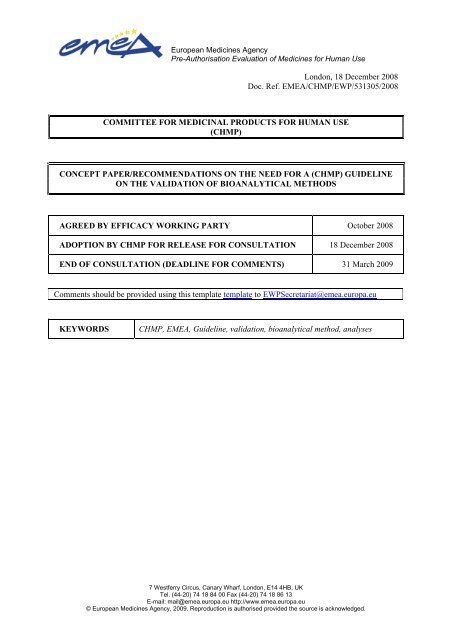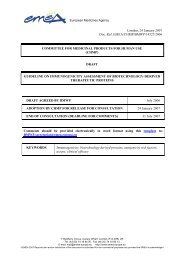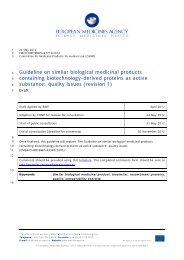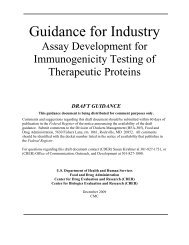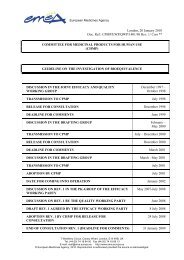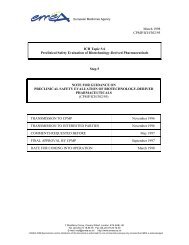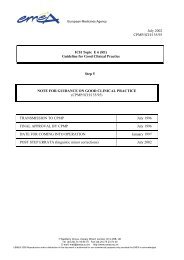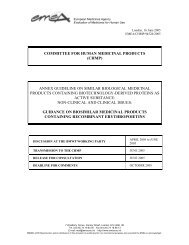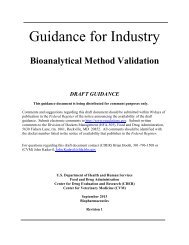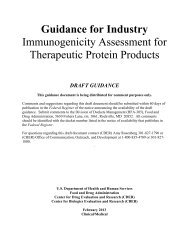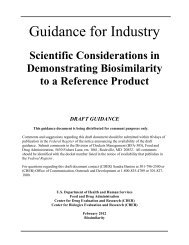EMA Concept Paper
EMA CONCEPT PAPER/RECOMMENDATIONS ON THE NEED FOR A (CHMP) GUIDELINE ON THE VALIDATION OF BIOANALYTICAL METHODS http://www.ipm-biotech.de/fileadmin/user_upload/pdf/guidelines/EMEA-bioanalytical-methods-March-2009.pdf
EMA CONCEPT PAPER/RECOMMENDATIONS ON THE NEED FOR A (CHMP) GUIDELINE ON THE VALIDATION OF BIOANALYTICAL METHODS
http://www.ipm-biotech.de/fileadmin/user_upload/pdf/guidelines/EMEA-bioanalytical-methods-March-2009.pdf
Create successful ePaper yourself
Turn your PDF publications into a flip-book with our unique Google optimized e-Paper software.
European Medicines Agency<br />
Pre-Authorisation Evaluation of Medicines for Human Use<br />
London, 18 December 2008<br />
Doc. Ref. EMEA/CHMP/EWP/531305/2008<br />
COMMITTEE FOR MEDICINAL PRODUCTS FOR HUMAN USE<br />
(CHMP)<br />
CONCEPT PAPER/RECOMMENDATIONS ON THE NEED FOR A (CHMP) GUIDELINE<br />
ON THE VALIDATION OF BIOANALYTICAL METHODS<br />
AGREED BY EFFICACY WORKING PARTY October 2008<br />
ADOPTION BY CHMP FOR RELEASE FOR CONSULTATION 18 December 2008<br />
END OF CONSULTATION (DEADLINE FOR COMMENTS) 31 March 2009<br />
Comments should be provided using this template template to EWPSecretariat@emea.europa.eu<br />
KEYWORDS<br />
CHMP, EMEA, Guideline, validation, bioanalytical method, analyses<br />
7 Westferry Circus, Canary Wharf, London, E14 4HB, UK<br />
Tel. (44-20) 74 18 84 00 Fax (44-20) 74 18 86 13<br />
E-mail: mail@emea.europa.eu http://www.emea.europa.eu<br />
© European Medicines Agency, 2009. Reproduction is authorised provided the source is acknowledged.
1. INTRODUCTION<br />
Measurements of drug concentrations are an important part of the data included in medicinal products<br />
applications. This can be as part of new drug or generic applications, but also to support variations.<br />
Moreover, critical decisions are made based upon drug concentrations, like in bioequivalence studies<br />
and interaction studies. Therefore the applied bioanalytical methods used must be well characterised,<br />
fully validated and documented to yield reliable results that can be satisfactorily interpreted. However,<br />
no CHMP guidance is available on this topic.<br />
2. PROBLEM STATEMENT<br />
The CHMP does not have a Note for Guidance on validation of bio-analytical methods, although<br />
analytical methods and validations are included in most application dossiers. The new guideline will<br />
provide recommendations for the validation of a bioanalytical method. Next to that, specific topics<br />
should be addressed with regard to the bioanalytical method, i.e. the actual analysis of study samples.<br />
Furthermore it is not the purpose of the new guideline to introduce fully new criteria, but it should be<br />
in line with current scientific knowledge on this topic.<br />
3. DISCUSSION<br />
The Note for Guidance on the validation of bioanalytical methods will apply to Marketing<br />
Authorisation Applications for human medicinal products submitted in accordance with the Directive<br />
2001/83/EC as amended, in which the analysis of drug concentrations is part of the application.<br />
The topics to be included in this guidance are:<br />
Good Laboratory Practice (GLP).<br />
Which conditions should be applied and can be requested. Attention will be paid to quality control<br />
and quality assurance system.<br />
Complete validation of an analytical method<br />
The main objective of method validation is to demonstrate the reliability of a particular method for<br />
the quantitative determination of an analyte concentration in a specific biological matrix, like<br />
blood, plasma or urine. The main characteristics of a bioanalytical method essential to ensure the<br />
acceptability of the performance and the reliability of analytical results are:<br />
- specificity; sensitivity, the response function (calibration curve performance), accuracy,<br />
precision, recovery, dilution integrity, stability of the analyte(s) in the biological matrix and<br />
the stock solutions under processing conditions and during the entire period of storage, and<br />
robustness.<br />
• Reference standards<br />
Criteria to ensure the quality and/or purity of the reference standards and possible internal<br />
standards will be provided in .the guideline<br />
Regarding validation of the analytical method the following issue will be included:<br />
• Specificity<br />
How to evaluate specificity, not only with regard to the matrix, but also with regard to<br />
interference by metabolites of the drug(s) applied, or interference of degradation products<br />
formed during sample preparation, and interference of possible co-medications.<br />
• Sensitivity<br />
How to determine and which criteria should be applied to:<br />
2/5
- Limit of detection<br />
- Lower limit of quantitation<br />
• Calibration curve<br />
Evaluation of the response of the instrument with regard to the analyte will be included.<br />
Furthermore attention will be paid what criteria should be applied with regard to accuracy and<br />
precision of the standards (back calculated concentrations).<br />
• Accuracy<br />
How many quality control samples (QC samples) should be used to evaluated accuracy. Which<br />
criteria should be applied: the following will be included:<br />
- Intra- or within-run accuracy<br />
- Inter- or between –run or –day accuracy<br />
• Precision<br />
In addition to accuracy, criteria on precision will be included, taking into account:<br />
- Intra-or within-run precision<br />
- Inter- or between –run or –day precision<br />
Furthermore attention will be paid to dilution integrity.<br />
• Recovery<br />
Evaluation of the recovery will be included.<br />
• Stability<br />
How to evaluate the stability of the analyte(s) to ensure that every step taken in sample preparation<br />
and during sample analysis does not affect the concentration of the analyte significantly.<br />
Which criteria should be applied.<br />
Attention will be paid to:<br />
- freeze and thaw stability of the analyte in the matrix from freezer storage conditions to<br />
room temperature<br />
- stability of the analyte in matrix stored in the refrigerator<br />
- bench top stability of the analyte in matrix at room temperature<br />
- long term stability of the analyte in matrix stored in the freezer<br />
- bench top stability of the processed sample at room temperature (dry extract or in the<br />
injection phase)<br />
- in-injector stability of the processed sample at injector temperature<br />
Furthermore, evaluation of the stock solutions will be taken into account.<br />
3/5
• Robustness<br />
How to consider robustness during the development and application phases of an analytical<br />
method with regard to e.g. instrument, operator or site changes.<br />
• Matrix effects<br />
Evaluation of matrix effects in LC/MS/MS methods will be included.<br />
Next to the complete validation, attention will be paid to:<br />
- cross validation;<br />
- partial validation.<br />
Bioanalytical method: analysis of (study) samples<br />
How to set up an analytical run.<br />
What acceptance criteria for an analytical run should be applied (accuracy and precision).<br />
Reanalysis of subject samples<br />
When may subject samples be reanalysed.<br />
What should be reported.<br />
Reintegration of chromatograms<br />
How to deal with reintegration.<br />
Study report<br />
Which reports should be provided.<br />
What should be included in the validation report.<br />
What should be included in the analytical report.<br />
4. RECOMMENDATION<br />
The Efficacy Working Party (EWP) recommends preparing a Guideline on the validation of<br />
bioanalytical methods as no European guidance exists in this area.<br />
5. PROPOSED TIMETABLE<br />
It is anticipated that a draft CHMP document may be released 8 months after adoption of the <strong>Concept</strong><br />
<strong>Paper</strong>. The draft document will then be released for 6 months of external consultation and following<br />
the receipt of comments it will be finalised within approximately 6 months.<br />
6. RESOURCE REQUIREMENTS FOR PREPARATION<br />
The preparation will involve the EWP Therapeutic subgroup on Pharmacokinetics (PK-EWP), with<br />
the contribution of the GCP and GLP Inspectors Working Groups.<br />
4/5
7. IMPACT ASSESSMENT (ANTICIPATED)<br />
Introducing a new guideline will be of benefit for industry, as no such guideline exists in EU.<br />
Moreover, it may lead to a consistent assessment between different Member States.<br />
8. INTERESTED PARTIES<br />
Industry and bioanalytical laboratories.<br />
5/5


